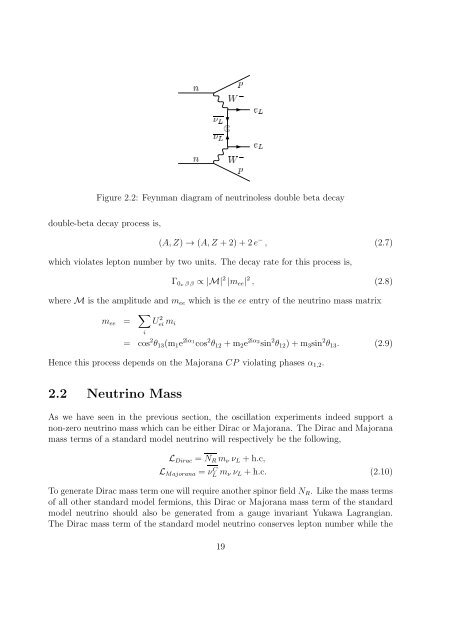PHYS08200604017 Manimala Mitra - Homi Bhabha National Institute
PHYS08200604017 Manimala Mitra - Homi Bhabha National Institute
PHYS08200604017 Manimala Mitra - Homi Bhabha National Institute
You also want an ePaper? Increase the reach of your titles
YUMPU automatically turns print PDFs into web optimized ePapers that Google loves.
Figure 2.2: Feynman diagram of neutrinoless double beta decay<br />
double-beta decay process is,<br />
(A,Z) → (A,Z +2)+2e − , (2.7)<br />
which violates lepton number by two units. The decay rate for this process is,<br />
Γ 0ν ββ ∝ |M| 2 |m ee | 2 , (2.8)<br />
where M is the amplitude and m ee which is the ee entry of the neutrino mass matrix<br />
m ee = ∑ i<br />
U 2 eim i<br />
= cos 2 θ 13 (m 1 e 2iα 1<br />
cos 2 θ 12 +m 2 e 2iα 2<br />
sin 2 θ 12 )+m 3 sin 2 θ 13 . (2.9)<br />
Hence this process depends on the Majorana CP violating phases α 1,2 .<br />
2.2 Neutrino Mass<br />
As we have seen in the previous section, the oscillation experiments indeed support a<br />
non-zero neutrino mass which can be either Dirac or Majorana. The Dirac and Majorana<br />
mass terms of a standard model neutrino will respectively be the following,<br />
L Dirac = N R m ν ν L +h.c,<br />
L Majorana = ν C L m ν ν L +h.c. (2.10)<br />
To generate Diracmass termone will require another spinor field N R . Like the mass terms<br />
of all other standard model fermions, this Dirac or Majorana mass term of the standard<br />
model neutrino should also be generated from a gauge invariant Yukawa Lagrangian.<br />
The Dirac mass term of the standard model neutrino conserves lepton number while the<br />
19
















